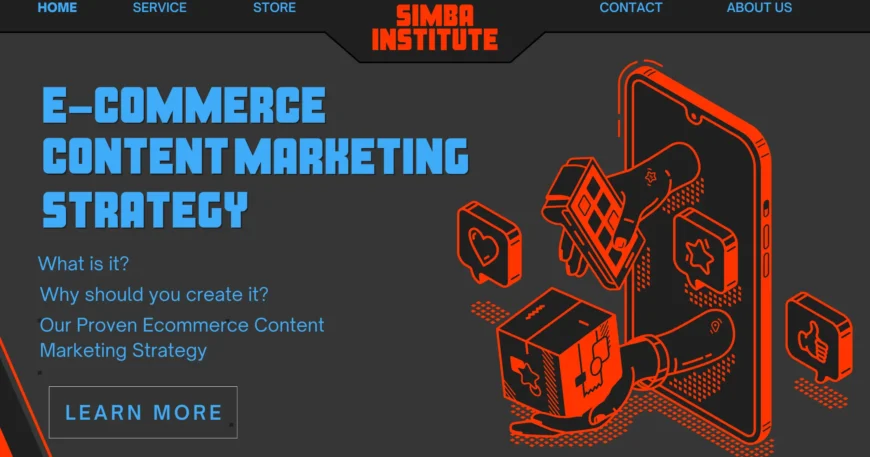Today, we’re offering our solution to assist DTC brands grow quickly through content marketing.
We’ll lay out how to find the best content types to write about, develop realistic ranking targets that will lead to greater sales, and analyse your progress to drive better outcomes moving forward in order for you to adopt the same strategy for your business.
Prefer to work with professionals who perform this work regularly? Give us a little background information about yourself, and we’ll set up a free consultation call.
What Is an eCommerce Content Marketing Strategy?
A content strategy for e-commerce sites is a strategy for planning, producing, and distributing high-quality material that target audiences will find.
However, the secret is to accomplish it in a way that generates a solid ROI.
Typically, this is done through lengthy posts produced through carefully thought-out SEO blogging. Once things are confirmed, other factors could include:
- Email marketing
- Infographics
- Lead magnets
- Video content
plus more.
Making an ecommerce-based content plan for your store requires taking a different approach from your grandmother’s marketing strategies.
In contrast to a conventional hard sell, the majority of examples of ecommerce content use a soft sell that creates trust by resolving an issue. These tactics are at the top of the list for content trends in 2022 because they are so effective (provided that the brand in question genuinely offers relevant information in its content).
Your goal, or more precisely, your ecommerce roadmap strategy, is to produce top-notch content that ranks well on Google, converts site visitors into leads, and sells like hotcakes for you.
If you don’t already have an ecommerce strategy centred on content, do it right away. And always start with blogging (it has the longest content lifespan available).
For a variety of reasons, which I’ll explore next, your content strategy for your e-commerce website is EXTREMELY critical.
Why Should I Create a Content Strategy for My Ecommerce Website?
Don’t even begin to discuss the ROI of content marketing with me (or do, I’ll go on and on about it)!
The following are just a few advantages of a well-executed ecommerce content strategy:
- Content marketing provides immediate responses to leads’ inquiries, which increases credibility, trust, and sales.
- It can generate a tonne of traffic for your e-commerce website.
- Compared to paid advertising, there is a huge ROI (and organic social performs 1,000 times better).
- It’s a strategy to distinguish and update your brand.
- Your conversion funnel is expertly optimised by ecommerce content marketing to dramatically increase those conversions (yes, even “while you sleep”).
- In addition to any other streams of income you may have (like a brick and mortar store), it can (and should) become your main source of income.
- Sustainable content strategy can help you create an empire over the long term because it can multiply over time.
It takes courage to run a business, and ecommerce firms are no exception. You’ll not only increase sales once you’ve developed a repeatable content marketing ecommerce plan, but you’ll also have the clarity and concentration necessary to scale to extraordinary heights online.
Next, I’ll walk you through the steps of developing a successful e-commerce content strategy.
Our Proven Ecommerce Content Marketing Strategy
Our content approach is divided into four parts.
- Analyse both you and your rivals
- Map out the content categories you should concentrate on and your short- and long-term ranking objectives.
- Review performance and change course for better outcomes.
1. Audit Yourself and Your Competition
Understanding how you compare to your competitors is the first step in expanding your business through content marketing.
Analyse your biggest competitors first. Here, Lauren White explains how we go about examining your competitors.
Draw a map of their best-performing content, valuable keyword rankings, most-linked pages, and other factors.
Then go through the same procedure with your e-commerce website.
Ask yourself the following questions:
- Where do your rivals rank higher than you?
- What pages do your rivals own that you don’t?
- What kind of content does their website publish?
Sort those keywords into categories for which you can create in-depth materials.
Ask yourself if you can develop one resource that would satisfy someone searching for those two independent keywords whenever you’re unsure whether to create two separate resources for two keywords. Create two distinct resources if not.
2. Identify What Types of Content to Focus On
The most prosperous e-commerce companies focus their content efforts on certain content objectives.
We break this into four components:
- Content that promotes awareness
- sales
- thought leadership
- and culture (we’ll bypass this one for now).
Awareness Content drives brand awareness to expand exponentially. The larger, informative resources that your target audience looks up online make up awareness content.
Sales Centric Content increases conversions and income. Sales-focused content includes:
- Resources that explain how your product alleviates customer problems
- Comparisons between your product and similar alternatives
- Case studies and customer testimonials
- Resources for customer service that enhance the client experience and promote repeat business (such as product tutorials, FAQs, etc.).
Thought Leadership Content draws the titans in your sector to increase the authority of your brand. The creation of thought leadership content requires years of industry knowledge due to its unique procedures, industry projections, and other insights.
Although this content won’t receive much exposure, getting it in front of industry influencers will motivate them to support you and promote your content with their followers on social media, boosting the legitimacy of your business.
Finding the Right Balance Between Content Types
For determining how much of your efforts should go into each form of content, there is no simple answer.
But until they achieve a few thousand readers per month, we advise firms to concentrate their efforts primarily on sales- and awareness-focused content.
Few direct sales will be generated via awareness content. However, awareness content raises brand awareness, makes it much easier to develop links to it, and directs users to sales-focused content and particular product pages.
High conversion rates and much more purchases per website visitor can be expected from sales-focused content. However, search engine traffic to sales-focused content is typically substantially smaller.
Why?
- It will be significantly harder to rank for search queries with a high degree of commercial purpose (for example, “buy red shoes”) than for the majority of educational search queries (for example, “types of shoes”).
- Prior to learning about your company, potential clients won’t look up themes like “[your business] success stories”.
3. Map Out Short-Term vs. Long-Term Ranking Goals
By combining short- and long-term ranking goals, identify those content opportunities.
Here, we examine short-term vs. long-term ranking goals in further detail.
To determine how many high-quality links we should construct to a page focusing on each keyword theme in order to rank in Google’s top 10, we use our Root Domain Benchmark tool.
After that, we concentrate our link-building efforts on a variety of search themes that are doable to rank for in 1 to 3 months while putting special emphasis on some longer-term ranking objectives that could take 12 months or more to rank for.
This device is far from ideal. However, it is a perfect barometer for determining how much effort should be put into ranking for a particular theme.
Here are some of our top link-building strategies that you may utilise right away.
Using the term difficulty scores from Ahrefs and more complex Google Sheet algorithms, we developed this tool internally. However, Ahrefs has access to a lot of this information.
For instance, Ahrefs believes that in order to rank in the top 10 results of Google for “types of shoes,” you would need to build links from 22 distinct domains.
4. Review Performance and Pivot for Better Results
The fourth step is to evaluate your performance.
On a consultation call every month, we carry out this. For our clients, we put a lot of effort into reviewing site performance and monitoring competition activity.
Find out more about the format of our monthly consultation calls here:You can use the following inquiries to do your own research by stealing some of the ones we ask ourselves:
- What was the main objective behind each piece of material you produced? What measurements can we use to gauge our performance? Which material is performing the best?
- Do you observe any trends in content types (videos, blog posts, infographics, podcasts, quizzes, etc.) that help them more effectively accomplish their objectives?
- How well did your online shop do last month vs the month before? in comparison to the identical month previous year? Which pages performed better? Which pages’ performance fell off?
- How are you trending for the keywords that are most important to you? Every day, we monitor all keyword ranks. Most keyword research tools allow you to do this; we advise using SEMRush or Ahrefs.
Based on this data, adjust your content strategy to reduce efforts that aren’t yielding the desired outcomes and increase efforts that are.
Tying Your Content Strategy for Ecommerce Websites Together
I have no doubt that you will succeed if you adhere to the guidelines in this guide for developing an ecommerce marketing plan and content strategy.
Sincerely, I wouldn’t be surprised if your postings quickly overtake the industry leaders on Google and take up residence at the top of many popular keywords.
But if you want to understand more about this and how it’s done in detail, I encourage you to sign up for my effective session on Content Marketing for Ecommerce.




